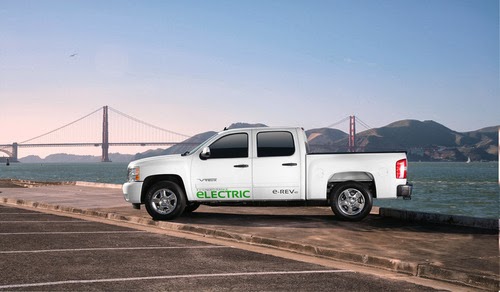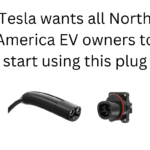Via Motors unveiled today their “extended range electric” truck meant for commercial fleet customers, such as their partner Pacific Gas and Electric.
Via Motors today unveiled their plug-in hybrid (a.k.a. extended range electric) trucks today at the North American International Auto Show (NAIAS) in Detroit. Joining Via Motors was a partner company, Pacific Gas and Electric, the primary gas and electric utility in north and central California, who has worked with Via Motors since 2008 to ensure their trucks would be suitable for use by utility customers.
Via Motors manufactures a line of electrically powered pickup trucks, and are promising to unveil both SUV’s and Vans soon using the same drive train technology. These are electric vehicles carrying an on-board generator capable of both recharging the battery pack (making the trucks a plug-in hybrid) and providing on-site power to run tools required by construction crews. Borrowing terminology from General Motors, Via Motors uses the phrase “extended range electric vehicle” to describe their drive train, rather than the phrase “plug-in hybrid” many use to describe vehicles having dual power systems (gasoline and electric) and allowing the vehicle to be plugged in to recharge the battery pack. For what it’s worth, Bob Lutz, former Chairman of GM and billed as the Father of the Chevy Volt, the vehicle for which the “extended range electric vehicle” terminology was coined, serves on Via Motors’ board of Directors.
The Via Motors Extended-Range Electric VTrux carries a 24 kilowatt-hour liquid cooled lithium ion battery pack that delivers up to 40 miles driving range. The 300 kilowatt motor couples directly to the drive shaft delivering 400 horsepower, or 400 nM (300 ft-lb) of torque. The gasoline half of the vehicle is a 4.6 liter gasoline powered engine coupled directly to a 150 kilowatt electric generator, that can be used to both recharge the battery pack and to power power tools at work-sites. The bed also has ample payload capacity, 1500 lbs in the bed, and the truck has enough power to haul a trailer.
You might look at the Via Motors website and wonder, “where are they getting these trucks” and “do they manufacture the trucks themselves”? The Via Motors website does not give an answer, however reports today from Detroit indicate that Via Motors business is in converting trucks manufactured by OEM’s. Their display vehicles in Detroit are GM vehicles, a heavy-duty van, one Chevy Silverado 1500, and a Suburban 2500. Additionally Via Motors says they are agnostic to specific original manufacturers, and are open to constructing EREV conversions of (for example) Dodge Ram pickup trucks depending on requests from Via’s customers.
While it’s rare for regular retail vehicle consumers to completely customize their vehicles, commercial vehicle customization shops are quite common for commercial fleet customers. An example are the utility trucks typically used by a company like PG&E, a partner with Via Motors. PG&E has their own shop to customize trucks to their own specification, primarily to instal the equipment and storage cabinets required in their work of maintaining electrical and gas lines in California. There are hundreds of truck customization companies around the U.S. and larger fleet customers, like PG&E, will have their own customization shop.
PG&E begin testing two of the trucks last year and projects expected annual fuel and maintenance savings of $7000 per vehicle compared with conventional trucks, said Greg Prutt, senior vice president of corporate affairs at PG&E. Apparently they plan to buy 10-12 more of the trucks in the near future. Bob Lutz talked about Coca-Cola and Verizon as two potential customers who are currently evaluating the Via Motors VTrux.
“This truck has the potential to significantly transform the way we manage electrical outages for our customers,” said PG&E Corporation’s Senior Vice President of Corporate Affairs Greg Pruett. The press release from PG&E described the trucks potential for being connected to the electricity grid, providing power to the grid in case of power outages, eliminate power outages during planned maintenance, and boost the electric grid when needed.
PG&E currently has a large fleet of alternative-fueled vehicles including natural gas vehicles as well as hybrid and electric cars. That company is continually testing and validating alternative fuel drive trains not just to reduce their emissions footprint, but to address noise concerns for night-time operations. A common complaint lodged against utility companies is the noisy trucks that might operate in neighborhoods late at night to repair outages. An electric truck could let a crew take on the same repair work, while drastically reducing the noise.
Via Motors expects to convert up to 3,000 GM vehicles this year and increase production volumes in the coming years. Their website says they’re open for sales to fleet customers right now, and starting in 2013 will be open to sales to retail consumers. The price begins at $79,000 (“in volume”) and potential buyers can place reservations now for 2013 delivery.
VIA Motors rolls out converted hybrid electric trucks![]()
2012 NAIAS: Electric Work Trucks From Via Motors![]()
Originally published at TorqueNews: http://www.torquenews.com/1075/motors-introduces-plug-hybrid-electric-truck-detroit-partnering-pge![]()
- Highway design could decrease death and injury risk, if “we” chose smarter designs - March 28, 2015
- GM really did trademark “range anxiety”, only later to abandon that mark - March 25, 2015
- US Government releases new regulations on hydraulic fracturing, that some call “toothless” - March 20, 2015
- Tesla Motors magic pill to solve range anxiety doesn’t quite instill range confidence - March 19, 2015
- Update on Galena IL oil train – 21 cars involved, which were the supposedly safer CP1232 design - March 7, 2015
- Another oil bomb train – why are they shipping crude oil by train? – Symptoms of fossil fuel addiction - March 6, 2015
- Chevron relinquishes fracking in Romania, as part of broader pull-out from Eastern European fracking operations - February 22, 2015
- Answer anti- electric car articles with truth and pride – truth outshines all distortions - February 19, 2015
- Apple taking big risk on developing a car? Please, Apple, don’t go there! - February 16, 2015
- Toyota, Nissan, Honda working on Japanese fuel cell infrastructure for Japanese government - February 12, 2015













